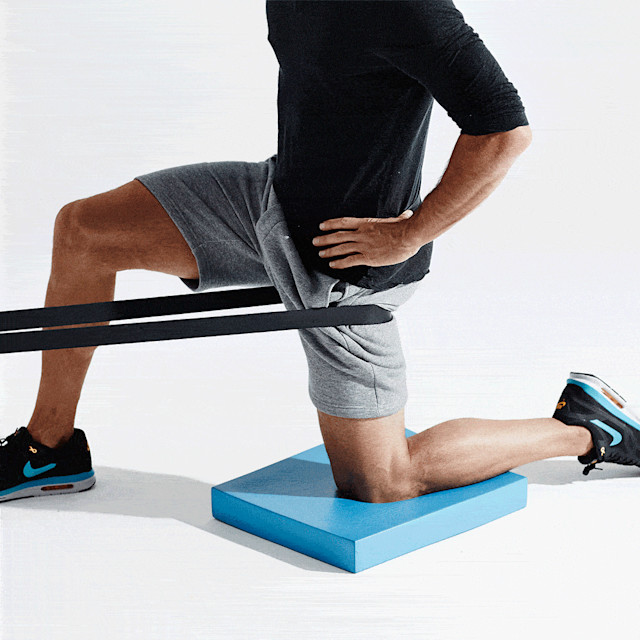First ankles, now hips: Master trainer Josh Stolz shows you how focusing on forgotten areas unlocks a fitter physique.
Last week, we began our mobility work at a critical part of the chain: the ankles. Due to the sheer number of bones, joints, muscles, tendons and ligaments in your feet and ankles, it stands to reason that any immobility there will throw your body off-balance. In the second installment of our series, Stolz shifts his focus a bit higher, but again, the body's connectivity is at work. "Think about the synergy between the hip, knee and ankle," he says. "The knee is stuck in the middle of these super-mobile joints, so if either the ankle or the hip is not moving correctly, it has a direct impact on the knee. Many fitness professionals call the knee a 'dumb' joint because it's stuck in the middle with no place to go."
And as critical as mobility is to effective movements—and thus results—it's equally necessary for injury prevention. Ankle and hip mobility play a particularly important role in knee issues. "Think about all of the injuries you hear of and what percentage of those involve the knee," says Stolz. "You have runner's knee, patella tendonitis, chondromalacia, just to name a few. The knee always takes the brunt for the hip and ankle. Joints and connective tissue can affect each other and cause pain without being the actual problem."
While doing this kind of work daily would be best, Stolz advocates all exercisers, and especially those who have increased their training frequency, set aside at least one day dedicated to (active) regeneration. And the key word is active: "Regeneration and recovery doesn't mean just lying around," says Stolz. "Doing these movements will increase circulation, blood flow, and improve recovery. You may even sweat a little and increase your heart rate. But overall, in the grand scheme, doing a little bit of this work every day will help to minimize tissue dysfunction.

R8 hip/knee mobility
Kneel, resting your left knee on a foam mat or yoga block, keeping your right knee bent 90 degrees. Using the R8 roller, slowly roll the length of your thigh from your hip to your knee. This is best done in one-inch intervals, alternating directions (roll up and down, rotate and roll diagonally, and so on). Switch legs and repeat.

VYPER hamstring/glute mobility
Sit with right leg extended in front of you, left knee bent and left foot flat, palms flat on the floor. Place the VYPER beneath your right knee, then lift yourself slightly off the ground. Slowly roll the VYPER along your hamstring, up to your glute, and back again; again, rolling in one-inch increments is best. Divide your leg into 2 to 3 sections so there is plenty of focus given to each segment of the hamstring and glutes. Switch legs and repeat.

VYPER hip/knee mobility
Start on all fours, knees bent, resting on your forearms. Position the VYPER above your right knee, and slowly roll up your thigh to your hip. Divide your thigh into 2 or 3 sections in order to cover a small amount of surface area at a time; rolling in one-inch increments is best. The closer you roll to the joint, knee or hip, the more effect you'll have on that particular joint. Switch legs and repeat.

3D flossing - knee
Stand in a split stance, your right leg forward and left leg back with a slight bend in your left knee. Tightly wrap a Voodoo Floss band around your right quad (the higher the band, the more hip-specific this will be). Hinging from the waist, use both hands to wring or twist your quad as you lunge slightly forward until your knee is above your toes, slightly rotating your hips as you do so. Continue for one minute, moving your hand placement from directly above your kneecap to your hip. Quickly unwrap the band and repeat on opposite leg. Your leg should be wrapped for no longer than 90 seconds.

Band-assisted hip mobility (saggital plane)
Place a foam mat or yoga block on the floor, then secure the end of a band around something solid, like a cable column or machine. Step your left leg through the opening of the band, facing the machine, and kneel your left knee onto the foam mat, directly beneath your hip, keeping right foot flat and right knee bent about 45 degrees. The band should be taut and directly beneath your glute. Place your hands on your hips, and gently drive your hips forward, keeping your pelvis pulled up to keep tension in the hip flexor, until your knee is bent 90 degrees. Continue for one minute; try moving forward and back slightly, keeping the pelvis tucked, then try moving hips side to side as well as making small circles to the left and to the right with your hips. Switch legs and repeat.

Band-assisted hip mobility (frontal plane)
Begin in the same position as the previous exercise, but step your right leg out about 45 degrees (so instead of a 6 on a clock, it should be at an 8 or 9), keeping your knee bent 90 degrees. With your torso facing forward, gently drive hips to your right until your right knee is above your toes. Continue for one minute; again, be sure to move forward and back, side to side, and make small circles to the left and right. Switch legs and repeat.
Get More Fit Body Secrets:
Photographed by Mike Rosenthal; Grooming by Marina Gravini; Art Direction + Styled by Ashley Martin
